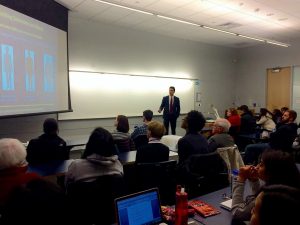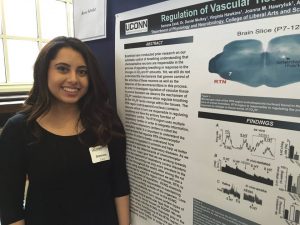UConn Year of Graduation (Undergraduate): 2009
Undergraduate Major(s): Computer Science
Currently Employed By: University of California San Francisco, Liver transplant anesthesiology fellow
Updates: Moved to San Francisco to pursue liver transplant anesthesiology and dip my feet in to Silicon Valley, maybe come away with a consulting position or connections to the startup world in med tech!
Author: Hoffmann, Jessamy
Rowe Researcher: The Effects of Cranberry Consumption on Lipid and Lipoprotein Metabolism
 The Effects of Cranberry Consumption on Lipid and Lipoprotein Metabolism in Human Apolipoprotein A-I Transgenic Mice Fed a High Fat and High Cholesterol Diet
The Effects of Cranberry Consumption on Lipid and Lipoprotein Metabolism in Human Apolipoprotein A-I Transgenic Mice Fed a High Fat and High Cholesterol Diet
May 2017
Investigators: Christian Caceres, Dr. Ji-Young Lee, Dr. Young-Ki Park
The development of pathological conditions including cardiovascular disease are well documented to manifest from an obese state due to high lipid burden at adipose tissue and consequent low-grade inflammation. We hypothesized that anthocyanin-rich whole cranberry powder would prevent inflammation while simultaneously modifying high- density lipoprotein (HDL) metabolism to confer cardioprotection in C57BL/6J mice expressing human apolipoprotein A-I transgene (hApoAITg). Male hApoAITg C57BL/6J mice were fed a modified AIN-93M high fat/high cholesterol diet (HF/HC; 15% fat, 0.25% cholesterol by weight) with only the treatment group receiving 5% whole cranberry powder by weight for 8 weeks. Our results suggest that CR supplementation decreases obesity-induced inflammation in adipose tissue at least in part, by modulating energy metabolism in skeletal muscle. However, additional investigations are required to conclusively determine the effect of cranberry consumption on serum lipids and HDL metabolism.
Rowe Researcher: Tyrosine Phosphorylation of the Bacterial Stress Factor BipA

Tyrosine Phosphorylation of the Bacterial Stress Factor BipA aids in Adaptation and Pathogenicity
Summer 2016
Investigators: Akua Owusu and Jui Chaugule
Faculty Advisors: Dr Victoria Robinson and Dr David Benson
BipA is a multi-domain prokaryotic GTPase universally conserved in pathogenic bacteria. It regulates a number of virulence events including pedestal formation, flagella mediated motility and expression of virulence genes. Most importantly, BipA null mutants are avirulent, suggesting it is a prime target for antimicrobial development. Central to the function of BipA are its GTPase activity and its association with the ribosome. An examination of the ribosome binding properties of the protein revealed that BipA has two ribosome binding modes. Under normal growth conditions, GTP-bound BipA associates with 70S ribosomes. However, under conditions of stress, ppGpp-bound BipA associates with 30S ribosomes. A study by the O’Connor group at the University of Southampton (UK) demonstrated that BipA undergoes phosphorylation on one of its tyrosine residues and perhaps this modification may play a role in its ability to regulate virulence processes. Therefore, the purpose of my project was to identify the tyrosine phosphorylation sites in EHEC BipA and then determine how this modification affects its biochemical properties particularly its GTPase activity.
Rowe Alumni Spotlight: John Zyzo

UConn Year of Graduation (Undergraduate): 2012
Undergraduate Major(s): Molecular and Cell Biology
Currently Employed By: Waterbury Smiles and Old Greenwich Dental Associates, Licensed General Dentist
Updates: Recently graduated from Danbury Hospital GPR and currently practicing comprehensive general dentistry in Waterbury and Greenwich, CT.
Honors Alumni Spotlight: Brittany Bendel
UConn Year of Graduation (Undergraduate): 2015
Undergraduate Major(s): Chemical Engineering
Currently Employed By: Teach for America, Corps Member
Updates: I am currently training to be a secondary math teacher through teach for america. I will be teaching in Hartford in the fall!
Rowe Alumni Spotlight: Elena Carrington
UConn Year of Graduation (Undergraduate): 2017
Undergraduate Major(s): Molecular and Cell Biology
Currently Employed By: Dental Student
Updates: I am starting dental school on August 9th! I am very excited, but also nervous.
Rowe Alumni Spotlight: Mallory Perry
UConn Year of Graduation (Undergraduate): 2014
Undergraduate Major(s): Nursing
Currently Employed By: CT Children’s Medical Center, Clinical Nurse III
Updates: I’ve recently passed a certification exam, earning the title of Certified Pediatric Nurse (CPN). Also, as of June 2017 I have passed my qualifying exams for the PhD program, earning a Master of Science in Nursing along the way.
Rowe Alumni Spotlight: Kewa Jiang
UConn Year of Graduation (Undergraduate): 2016
Undergraduate Major(s): Molecular and Cell Biology
Currently Employed By: Med Student
Updates: Will be starting medical school at Albert Einstein College of Medicine this fall, class of 2021!
Rowe Researcher: Perceived Discrimination Affecting Muslim Health
Perceived Discrimination Affecting Muslim Health
2016-2017
Investigators: Sara Hasan, Michelle Morris
Faculty Advisor: Rick Gibbons
In the past decade, Muslim discrimination has increased to an all-time high. Multiple research journals have identified that discrimination can have adverse health effects on people of certain races. While studies have predominantly been researched towards African-Americans and Hispanics, I questioned how discrimination affects Muslims around the United States. My project aimed to understand the effects discrimination against Muslims has on their overall mental and physical health. Using an online survey website, the first study took place approximately one week after the 2016 United States Presidential election to see if there were adverse health effects present in Muslims, due to the election results. With the same participants for the second study, four months after the election, we will be maintaining contact to see if more health issues, if any, have arisen or if the previous ones have continued on since then. Along with the Muslim participants, we included a significant subsample of non-Muslims to compare their health behaviors during both waves of the study. This project analyzes the issues of Muslim discrimination and how it affects the health of Muslims in the United States.
Rowe Researcher: Regulation of Animal Vascular Tissue

Regulation of Animal Vascular Tissue in a Brainstem Respiratory Center
Spring 2015-Fall 2016
Investigators: Dr. Daniel Mulkey (Associate Professor), Virginia Hawkins (Post doc fellow), and Samana Zaidi
I have worked in Dr. Daniel Mulkey’s lab investigating the processes involving regulation of animal vascular tissue in the brainstem respiratory center. We have been using mammalian models to conduct our research, therefore, rats and mice were utilized. Our research has been focused on chemoreception which is the mechanism by which breathing is regulated as levels of CO2 and H+ increase or decrease in tissues. An important region of interest of ours is the retrotrapezoid nucleus known as the RTN. Within the RTN there are neurons that control breathing. An important channel is contained within the RTN region known as the KCNQ channel. We focused on multiple KCNQ channels primarily KCNQ2 and KCNQ3. These channels are potassium channels that are critical for brain function. We investigated the effects of loss of function and gain of function on KCNQ channel variants and what the response leads to be. In addition, the research was further applied to how we can use KCNQ2 channels to target patients with encephalopathy.